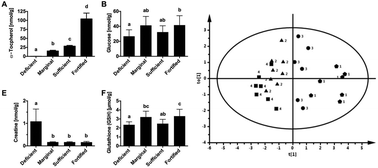Non-targeted 1H-NMR-metabolomics suggest the induction of master regulators of energy metabolism in the liver of vitamin E-deficient rats†
Abstract
The essential function of vitamin E in vivo is not fully understood. Several studies addressed changes in the pattern of gene expression induced by vitamin E, but often did not investigate if these changes altered biochemical pathways and are eventually translated into biological function. We therefore used 1H-NMR metabolomics to investigate the biochemical effects in the liver of rats caused by long-term feeding with diets deficient (dVE; α-tocopherol (αT), <1; γ-tocopherol (γT), <1; all values in mg kg−1 diet), marginal (mVE; αT, 6; γT, 11), sufficient (sVE; αT, 12; γT, 24), or fortified with vitamin E (fVE; αT, 140; γT, 24). The concentrations of four polar hepatic metabolites were affected by the vitamin E content of the diet; glucose was lower and creatine, phosphocholine, and betaine were higher in deficient compared with rats receiving vitamin E. To achieve further biochemical insight, we investigated transcriptional changes in genes involved in the regulation of metabolic pathways related to these metabolites. Transcription of PGC1α, PPARα, and PPARγ, transcription factors controlling energy metabolism, was lower and that of the fatty acid translocase CD36 higher in animals fed vitamin E-deficient compared to those fed vitamin E-replete diets. Our data thus indicate that consumption of a vitamin E-deficient diet may alter hepatic energy metabolism in rats.


 Please wait while we load your content...
Please wait while we load your content...